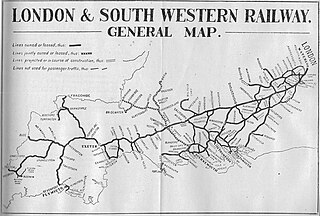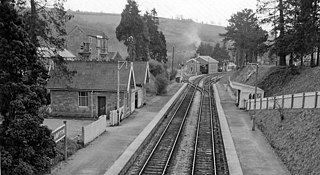Related Research Articles

Bristol Temple Meads is the oldest and largest railway station in Bristol, England. It is located 118 miles 31 chains away from London Paddington. It is an important transport hub for public transport in the city; there are bus services to many parts of the city and surrounding districts, with a ferry to the city centre. Bristol's other major station, Bristol Parkway, is a more recent station on the northern outskirts of the conurbation. It is the busiest station in South West England.

The London and South Western Railway was a railway company in England from 1838 to 1922. Originating as the London and Southampton Railway, its network extended to Dorchester and Weymouth, to Salisbury, Exeter and Plymouth, and to Padstow, Ilfracombe and Bude. It developed a network of routes in Hampshire, Surrey and Berkshire, including Portsmouth and Reading.

Gosport is a town and non-metropolitan borough, on the south coast of Hampshire, South East England. At the 2021 Census, its population was 81,952. Gosport is situated on a peninsula on the western side of Portsmouth Harbour, opposite the city of Portsmouth, to which it is linked by the Gosport Ferry. Gosport lies south-east of Fareham, to which it is linked by a Bus Rapid Transit route and the A32. Until the last quarter of the 20th century, Gosport was a major naval town associated with the defence and supply infrastructure of His Majesty's Naval Base (HMNB) Portsmouth. As such over the years extensive fortifications were created.

Ryde Pier is an early 19th century pier serving the town of Ryde, on the Isle of Wight, off the south coast of England. It is the world's oldest seaside pleasure pier. Ryde Pier Head railway station is at the sea end of the pier, and Ryde Esplanade railway station at the land end, both served by Island Line trains.

The Isle of Wight Railway was a railway company on the Isle of Wight, United Kingdom; it operated 14 miles of railway line between Ryde and Ventnor. It opened the first section of line from Ryde to Sandown in 1864, later extending to Ventnor in 1866. The Ryde station was at St Johns Road, some distance from the pier where the majority of travellers arrived. A tramway operated on the pier itself, and a street-running tramway later operated from the Pier to St Johns Road. It was not until 1880 that two mainland railways companies jointly extended the railway line to the Pier Head, and IoWR trains ran through, improving the journey arrangements.

Stokes BaySZ 590 980) is an area of the Solent that lies just south of Gosport, between Portsmouth and Lee-on-the-Solent, Hampshire. There is a shingle beach with views of Ryde and East Cowes on the Isle of Wight to the south and Fawley to the south west. The settlement of Alverstoke is close by.

Stoke-on-Trent railway station is a mainline railway station serving the city of Stoke-on-Trent, on the Stafford to Manchester branch of the West Coast Main Line. It also provides an interchange between local services running through Cheshire, Staffordshire and Derbyshire.

Fareham railway station is on the West Coastway Line, situated about 0.62 miles (1 km) from the town of Fareham in Hampshire, England. It is 84 miles 21 chains (135.6 km) down the line from London Waterloo.

Gourock railway station is a terminus of the Inverclyde Line, located at Gourock pierhead, Scotland, and serves the town as well as the ferry services it was originally provided for.
The Kelvedon and Tollesbury Light Railway was a locally promoted railway company, intended to open up an agricultural district that suffered from poor transport links. The enactment of the Light Railways Act 1896 encouraged the promoters to persuade the dominant main line railway, the Great Eastern Railway (GER), to participate in the construction and operation of the line.
The Meon Valley Railway was a cross-country railway in Hampshire, England, that ran for 22 miles (36 km) between Alton and Fareham, closely following the course of the River Meon. At its northern (Alton) end, it joined with the Alton Line from London. It was conceived as an additional main line to the area around Gosport, and it was opened in 1903. It never fulfilled its planned potential, and remained a local line through sparsely populated agricultural areas, and it closed to passenger services in 1955; some local goods services continued until total closure in 1968.

The Exe Valley Railway was a branch line built by the Great Western Railway (GWR) in Devon, England, to link its Bristol to Exeter line with its Devon and Somerset Railway (D&SR), thereby connecting Exeter with Dulverton. The line was in use from 1884 until 1964.
The Hundred of Hoo Railway is a railway line in Kent, England, following the North Kent Line from Gravesend before diverging at Hoo Junction near Shorne Marshes and continuing in an easterly direction across the Hoo Peninsula, passing near the villages of Cooling, High Halstow, Cliffe and Stoke before reaching the Isle of Grain and the container port on its eastern tip, Thamesport. There used to be a short branch line leading from Stoke Junction to the coastal town of Allhallows but this closed from 4 December 1961, the same date on which the Hundred of Hoo line was closed to passenger services.

New Holland Pier railway station is a former railway terminus in North Lincolnshire, England. It stood at the seaward end of the New Holland Pier, which juts 1,375 feet (419 m) northwards into the Humber estuary at the village of New Holland. Its purpose was to enable railway passengers, vehicles and goods to transfer to and from ferries plying between New Holland and Hull.
The Gosport and Cosham lines were a collection of railway lines in southern Hampshire. Most of the lines are now closed but some elements are still in use, forming part of the West Coastway line. The lines originally linked to the main London to Southampton line via the Eastleigh–Fareham line and subsequently with a line from Southampton via Bursledon, both of which are still in use.
The Stokes Bay line was a short railway branch line in Hampshire, England, near Gosport. Associated with a new pier, it was intended to give direct and easy access from trains to steamers to the Isle of Wight in comparison to the conventional route through Portsmouth, which required a road transport connection though the town. Railway operation to the Stokes Bay pier started in 1863.
The Lee-on-the-Solent Line was a three mile long railway in Hampshire, England; it was built by the Lee-on-the-Solent Railway Company, promoted in association with a landowner's wish to develop a new seaside resort on his land.

Camerton (Somerset) railway station served the village of Camerton, England from 1882 to 1951 on the Bristol and North Somerset Railway. In common with the other stations on the line it had a single platform for passengers, but also had a loop line so that two trains could pass. Diverging away from the through line at the east end of the station was the access line and associated sidings belonging to Camerton colliery. There was a substantial station building on the platform - this originally had a canopy but this was removed after passenger services ceased.

Sheerness Dockyard railway station was the original terminus of the Sheerness line. It was built by the Sittingbourne & Sheerness Railway and opened in 1860. The station closed for passengers in 1922, closed for freight in 1963 and the buildings were demolished in 1971.
Gosport Road and Alverstoke railway station served the town of Gosport, Hampshire, England, from 1865 to 1915 on the Stokes Bay line.
References
- ↑ Quick, M E (2002). Railway passenger stations in England, Scotland and Wales - a chronology. Richmond: Railway and Canal Historical Society. p. 406. OCLC 931112387.
- ↑ "Disused Stations" . Retrieved 11 October 2021.
| Preceding station | Disused railways | Following station | ||
|---|---|---|---|---|
| Gosport Road and Alverstoke Line and station closed | Stokes Bay Railway and Pier Company Stokes Bay line | Terminus |